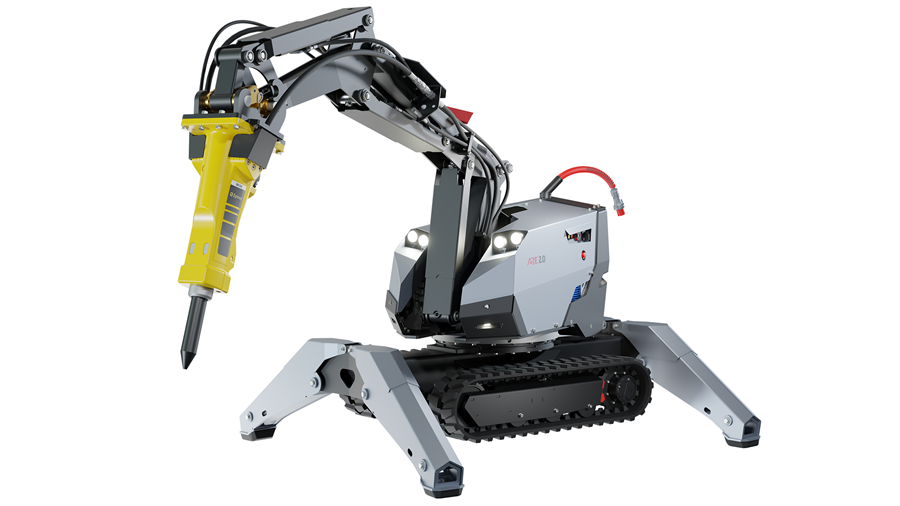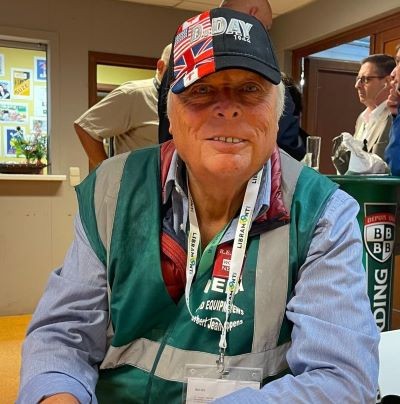R.E.News future Technology-Demo robots equipped with swappable Vanguard battery packs
 09/07/24-FR-English-NL-footer
09/07/24-FR-English-NL-footer
Robots de démonstration équipés de batteries Vanguard remplaçables
 An Advanced Robotic Engineering (ARE) demolition robot equipped with a Briggs & Stratton Vanguard battery pack. (Image: Briggs & Stratton)
An Advanced Robotic Engineering (ARE) demolition robot equipped with a Briggs & Stratton Vanguard battery pack. (Image: Briggs & Stratton)
Le producteur de moteurs américain Briggs & Stratton a fourni deux de ses batteries de marque Vanguard à la gamme de robots industriels de démolition de la société australienne Advanced Robotic Engineering (ARE).
Un bloc de batterie échangeable – le 48 V Si1,5 KWh – et un bloc fixe – le 48 V Fi3,5 kWh – ont été conçus pour fonctionner avec trois modèles de robots de démolition ARE : le 1.0, le 2.0 et le 3.0.
À l’origine, ARE a développé son propre pack de batteries mais a intégré les batteries Vanguard en raison de leur réputation de sécurité et de leurs performances dans « les conditions de fonctionnement les plus extrêmes ».
« Alors que le grand ARE 3.0 est alimenté par la batterie fixe 48 V Fi3,5 kWh de Vanguard, permettant au robot de démolition de fonctionner sur les chantiers pendant 30 minutes maximum, les plus petits modèles ARE 1.0 et 2.0 fonctionnent avec une batterie échangeable 48 V Si1,5 kWh. » a expliqué Briggs & Stratton. "Cette fonctionnalité offre une flexibilité opérationnelle supplémentaire grâce à l'interchangeabilité, car une batterie Si1.5 déchargée peut être facilement remplacée par une batterie complètement chargée."
Les blocs-batteries éliminent le besoin de faire passer des câbles vers les unités. Selon l'entreprise, l'élimination d'un câble d'alimentation réduit également la nécessité pour un employé de s'en occuper.
« Pendant qu'un opérateur contrôlait la machine, un autre aidait à naviguer dans le câble. En conséquence, le déplacement des machines était non seulement compliqué et prenait du temps, mais nécessitait également l'implication de plusieurs personnes sur le chantier », a déclaré Briggs & Stratton à propos d'un processus de démonstration robotique câblé.
Les robots ARE peuvent également fonctionner avec une alimentation par câble.
Krzysztof Jakubowski, PDG d'Advanced Robotic Engineering, a déclaré : « Nous avons calculé que dans une journée de travail typique de huit heures, les opérateurs de robots peuvent gagner au moins une heure en utilisant ce système hybride ARE/Vanguard par rapport aux robots actionnés uniquement par câble. »
NJC.© infos ARE
-----------------------------------------------------------------------------------------------------------------
 09/07/24-English
09/07/24-English
Demo robots equipped with swappable Vanguard battery packs
 An Advanced Robotic Engineering (ARE) demolition robot equipped with a Briggs & Stratton Vanguard battery pack. (Image: Briggs & Stratton)
An Advanced Robotic Engineering (ARE) demolition robot equipped with a Briggs & Stratton Vanguard battery pack. (Image: Briggs & Stratton)
US-based engine producer Briggs & Stratton contributed two of its Vanguard brand battery packs to the Australia-based Advanced Robotic Engineering’s (ARE) range of demolition industry robots.
A swappable battery pack – the 48V Si1.5 KWh – and a fixed pack – the 48V Fi3.5 kWh – were engineered to work with three ARE demolition robot models: the 1.0, 2.0, and 3.0.
Originally, ARE developed its own battery pack but integrated the Vanguard batteries due to their safety reputation and performance in “the most extreme operating conditions”.
“While the large ARE 3.0 is powered by Vanguard’s 48V Fi3.5kWh fixed battery, allowing the demolition robot to operate on job sites for up to 30 minutes, the smaller ARE 1.0 and 2.0 models run on a 48V Si1.5kWh swappable battery,” explained Briggs & Stratton. “This feature provides additional operational flexibility through interchangeability, as a discharged Si1.5 battery can be easily swapped with a fully charged one.”
The battery packs eliminate the need to run cables to the units. Eliminating a power cable, the company said, also reduces the need for an employee to wrangle it.
“While one operator controlled the machine, another assisted on navigating the cable. As a consequence, moving machines was not only complicated and time consuming, but also required the involvement of several people at the job site,” said Briggs & Stratton of a cabled robotic demo process.
The ARE robots can still operate with cable power, as well.
Krzysztof Jakubowski, CEO of Advanced Robotic Engineering, said, “We’ve calculated that in a typical eight-hour working day, robot operators can save at least one hour by using this ARE/Vanguard hybrid system compared to only cable-operated robots.”
NJC.© info ARE
-------------------------------------------------------------------------------------------------------------------
 09/07/24-NL
09/07/24-NL
Demorobots uitgerust met verwisselbare Vanguard-batterijpakketten
 An Advanced Robotic Engineering (ARE) demolition robot equipped with a Briggs & Stratton Vanguard battery pack. (Image: Briggs & Stratton)
An Advanced Robotic Engineering (ARE) demolition robot equipped with a Briggs & Stratton Vanguard battery pack. (Image: Briggs & Stratton)
De in de VS gevestigde motorproducent Briggs & Stratton heeft twee van zijn Vanguard-batterijpakketten bijgedragen aan het in Australië gevestigde Advanced Robotic Engineering (ARE)-assortiment robots voor de sloopindustrie.
Een verwisselbaar batterijpakket – de 48V Si1,5 KWh – en een vast pakket – de 48V Fi3,5 kWh – zijn ontworpen om te werken met drie ARE-slooprobotmodellen: de 1.0, 2.0 en 3.0.
Oorspronkelijk ontwikkelde ARE zijn eigen batterijpakket, maar integreerde de Vanguard-batterijen vanwege hun veiligheidsreputatie en prestaties in “de meest extreme bedrijfsomstandigheden”.
“Terwijl de grote ARE 3.0 wordt aangedreven door de vaste 48V Fi3,5kWh-batterij van Vanguard, waardoor de slooprobot tot 30 minuten op bouwplaatsen kan werken, werken de kleinere ARE 1.0- en 2.0-modellen op een 48V Si1,5kWh verwisselbare batterij,” legde Briggs & Stratton uit. “Deze functie biedt extra operationele flexibiliteit door uitwisselbaarheid, omdat een lege Si1.5-batterij eenvoudig kan worden vervangen door een volledig opgeladen batterij.”
Dankzij de batterijpakketten is het niet meer nodig om kabels naar de units te leggen. Het elimineren van een stroomkabel vermindert volgens het bedrijf ook de noodzaak voor een werknemer om ermee te worstelen.
“Terwijl de ene operator de machine bestuurde, hielp een andere bij het navigeren door de kabel. Als gevolg hiervan was het verplaatsen van machines niet alleen ingewikkeld en tijdrovend, maar vereiste het ook de betrokkenheid van verschillende mensen op de bouwplaats”, aldus Briggs & Stratton over een bekabeld robotdemonstratieproces.
De ARE-robots kunnen ook nog steeds met kabelvoeding werken.
Krzysztof Jakubowski, CEO van Advanced Robotic Engineering, zei: “We hebben berekend dat robotoperators op een typische achturige werkdag minstens een uur kunnen besparen door dit ARE/Vanguard hybride systeem te gebruiken in vergelijking met alleen kabelaangedreven robots. ”
NJC.© info ARE
---------------------------------------------------------------------------------------------------------------
Date de dernière mise à jour : 08/07/2024

















